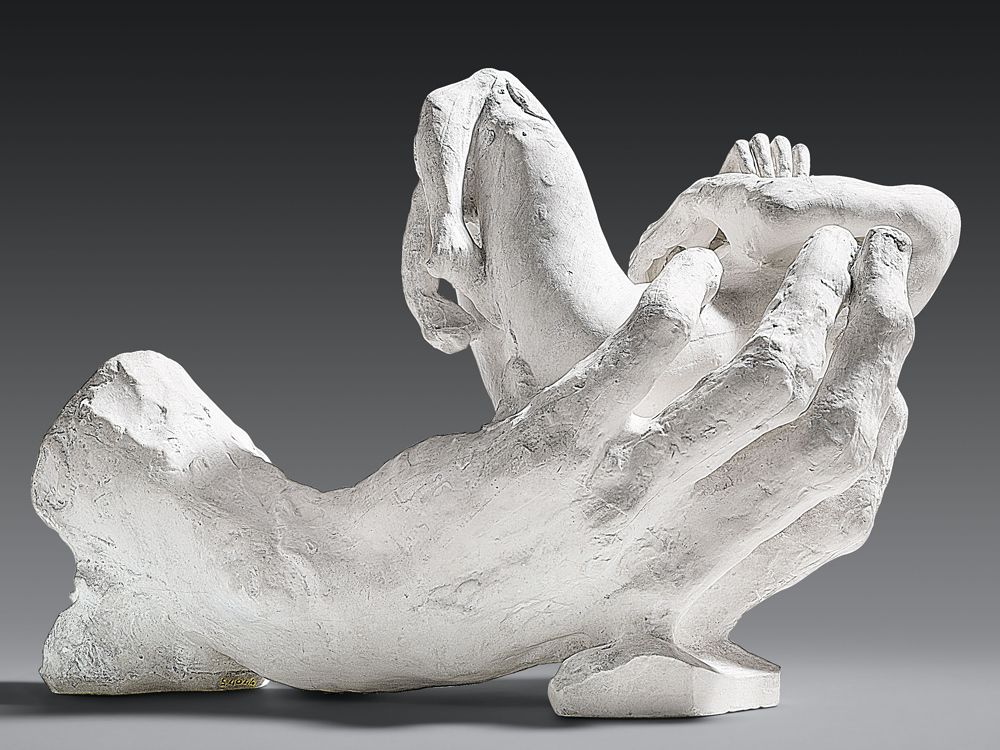In 1981, Time art critic Robert Hughes wrote of “Rodin Rediscovered,” the National Gallery of Art in Washington’s tribute to the 19th-century sculptor, that the exhibition triumphed because it served as “a means of making us see afresh the processes and fantasies, the failures and successes, of a very great artist whose work we assumed to be familiar.” More than three decades later, the Montreal Museum of Fine Arts, in collaboration with the Musée Rodin in Paris, has taken on the task of reintroducing Auguste Rodin to an audience that may consider, in Hughes’s words, “reproductions of The Kiss and The Thinker the very furniture of cliché.”
“Metamorphoses: In Rodin’s Studio” posits that only a thorough knowledge of the technical and cultural workings at play in studio practices can lead to fruitful analysis of questions surrounding sculpture. According to the show’s first didactic panel, the general public’s understanding of sculptural practice is lacking and “nourished by a great deal of confusion,” and this extends particularly to the little world contained within the studio of Rodin. In presenting some 300 works—including 170 sculptures, 100 fragile plasters, 15 marbles and a number of bronze castings, terracottas, stonewares, drawings, watercolours and photographs—this exhibition seeks to clarify what we do not know.
It explicates the processes behind the experimental practices—especially the fragmenting, enlarging, assembling and recycling of forms—that originated in Rodin’s Meudon studio and heralded the artist as a sculptural bellwether. Rodin’s interactions with his team of 50-odd assistants, among them live, nude models, clay beaters, mortar plashers, stone carvers, bronze casters, patinators and photographers, are examined as forms of artistic collaboration, and the audience is treated to an in-depth look at the many materials utilized in the studio. A haptic installation near the exhibition’s end, conceived for the visually impaired but open to be touched by all, draws the audience into Rodin’s studio just about as closely as is possible, then propels them into a final room housing works by Adad Hannah and Denys Arcand, situating the audience back in the present, surrounded by products of the sculptor’s resounding and formidable legacy.
There is no contesting the fact that Rodin’s agile modelling is to be held in reverence. He achieved public success only when he reached his late 30s, and spent those many years prior as a skilled labourer in various roles in the studios of other sculptors, mostly making hackneyed architectural decorations. It was not his sure hand, his primary tool, that made him remarkable, however. It was rather the torrent of expressive emotion, unabashed erotic candor and obstinate disregard for convention that was thrust forth from his fingertips and into his contorted, convulsing, non finito compositions like a vital life-force.
Here was an artist consumed by the pursuit of truth in movement. Enamoured by the aesthetics of the fragmentary condition of extant Greco-Roman statuary, he deliberately mutilated his figures while he was building them, lopping off arms, legs and even heads when he decided that their presence diminished the overall tenor and effect of his sculptures. He kept an arsenal of dissected abattis—limbs—that he quoted from earlier works and used to create hybrids. “A piece of beauty, ” Rodin once stated, “is beauty in its entirety.”
The gem of this exhibition is the installation of Vessels and “Flowers,” an assemblage of bowls and vases of various ancient Egyptian, Greek, Roman and Etruscan origin that have been filled with lithe little fairy bodies, most of them partial figures from The Gates of Hell, cast in plaster. Each is unique, pockmarked by air bubbles with visible cast seams, trapped in a bell jar and caressed by furtive shadows produced by the room’s dim, religious lighting. Rodin drew from his own collection of around 6,000 antiquities in creating these poetic compositions.
Rodin’s conflating of time periods was a tenaciously modern gesture, as was his approach to pedestals as integral parts of works. Not without reproach from his contemporaries, he dispensed with the prevailing notion that the primary locus for emotion was in the head of a figure, and instead imbued each body part with enough concentrated vigour that it functioned as a sovereign whole. He set the body free from its servile role as pedestal for the head and allowed it exalted autonomy. His iconoclastic efforts to reduce and simplify forms to heighten their expressiveness, as well as his refusal to idealize nature, set the stage for Modernism to arrive, and his influence can be seen in the works of Constantin Brancusi, Jean Arp, Henry Moore and many others. In this exhibition, the invisible work that happens behind closed studio doors is made visible, and the transitory processes inherent in sculpture—imperfection, experimentation, accident and invention—are privileged and ennobled as illustrations of the modern vitalism that Rodin brought to the fore of the discipline.









